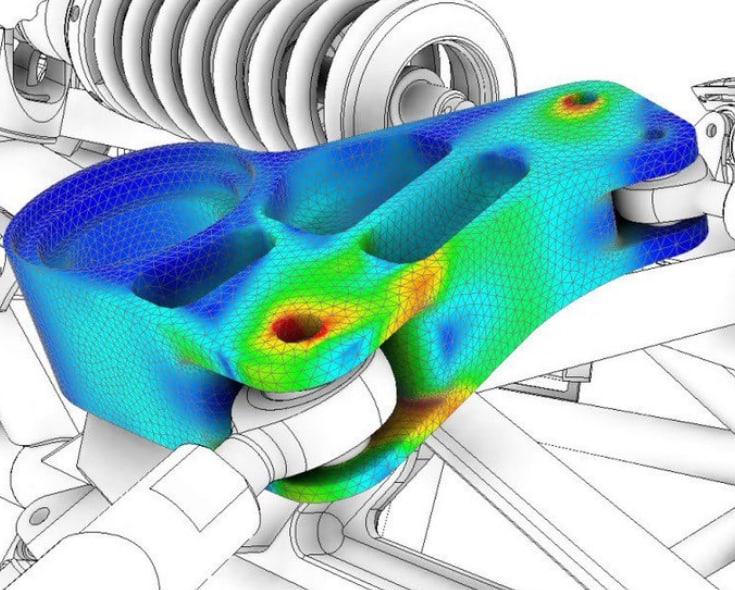Do you have supply chain issues? It’s not a question of if. It’s a question of when. Delayering products, outsourcing parts, and other factors will impact supply chains.
This blog post shows you how to address those challenges with Design for Manufacturability and Assembly (DFMA) and Simulation. The first step in avoiding supply chain issues is to have a solid product design and development process that allows you to identify and evaluate any issues during the design phase before the final product.
Simulating your design (using FEA & CFD) eliminates costly physical testing of the manufactured parts. Simulation results help you avoid costly rework during production, reduce scrap, and support lean manufacturing practices. Simulation provides information on ease of manufacture, assembly, disassembly, and serviceability.
Takeaway: There are several ways that DFMA and simulation can help prevent issues with the supply chain.
Keep these in mind when designing for manufacturability and assembly:
- Inflation: It was common for companies to outsource manufacturing in the past. However, we’re now seeing higher prices and increased demand to manufacture products closer to the customer.
Instead of outsourcing manufacturing to a foreign country, companies now outsource manufacturing within the U.S., which can potentially lower shipping costs and transportation time frames, giving you a shorter time to market. Keep this in mind when designing your product!
- Supply Chain: As more companies manufacture products closer to their customers, consider your supply chain and production cost when designing a new product. If you decide to manufacture your product at a plant overseas, will you be able to get supplies? If you manufacture locally, will you be able to find enough skilled workers or high-quality suppliers?
How will that affect the production cost? How can design for assembly (DFA) and design for manufacturing (DFM) reduce the number?
- Simulation (FEA & CFD): Because of how easy it is for companies to outsource production nowadays, it’s important that you thoroughly test your product before mass production begins. Simulation software like finite element analysis (FEA) and computational fluid dynamics (CFD analysis) shows you how your product will function once in the hands of real customers. It catches flaws before they become major problems.
Need Proof Before Taking Action
According to IHS Markit, Tesla’s Fremont factory will be named North America’s most productive auto plant in 2021. In August, the plant produced 10,061 vehicles, with 6,000 being Model 3 sedans. Tesla has approximately 6500 workers in their Fremont factory. That compares to 26,000 workers for GM and 14,300 workers for Ford Motor Company.
Interestingly, the Fremont plant was also the highest-ranked plant without robots on the assembly line. This is a remarkable feat because robots are being used more and more in automotive manufacturing. According to Tesla CEO Elon Musk, they’re planning to cut costs by adding more robots and cutting labor costs by 50%.
According to a McKinsey & Company analysis of auto manufacturing in North America, this is true. McKinsey reports that although Tesla’s Fremont facility can produce about 500,000 units a year, it only produced 103,000 units in 2017. This is far less than other auto manufacturers. For instance, General Motors produced 947,700 vehicles, and Ford Motor Company produced 894,400 vehicles over the same period.
Then how did Tesla’s Fremont factory become the most productive auto plant in North America in 2021?
In 2015, Tesla became the first car company to use digital design tools for its product design and assembly processes. These digital tools allowed them to simulate production processes and perform “what-if” scenarios. This helped them identify issues before they occurred.
These simulations are often used to test changes in materials or processes so that engineers can make adjustments early on without making expensive changes later. Companies then use this data to make better decisions about cost-effective designs vs. what raw materials are used.
It’s worth looking at how DFMA and simulation can help identify and avoid supply chain issues before they become problems. In DFMA (Design for Manufacturing & Assembly), companies make products based on physical constraints instead of potential ones.
Final Thoughts
DFMA (Design for Manufacturing & Assembly) helps companies like yours develop products that can be manufactured efficiently at any scale while minimizing risk. In the simulation, companies use software that shows how different production processes create products.
The Fremont facility earned its efficiency title by focusing on automation and process improvements with a “production hell” approach that kept quality control high and costs low. Tesla made sure their assembly lines were constantly reconfigured to keep up with production changes. These methods helped Tesla produce vehicles faster than any other American-based manufacturer.
This is how you avoid supply chain issues and more. Think about what Tesla is doing with DFMA and simulation. Now imagine how powerful it will prove for your manufacturing and assembly.









